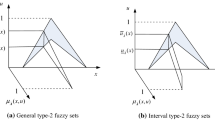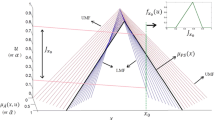Abstract
Type-2 fuzzy logic systems (FLSs) are gaining in popularity because of their capacity to handle rule uncertainties in a more complete way. Moreover, higher-order interval type-2 (IT2) FLS can reduce drastically the number of rules needed to perform the approximation and improve transparency and interpretation in many high-dimensional systems. This paper presents architecture and inference engine of generalized IT2 Takagi-Sugeno-Kang (TSK) FLS and the design method of higher-order IT2 FLS. An experimental acoustic emission (AE) signal modeling using a second-order IT2 TSK FLS in turning process is given to demonstrate the differences between the first-order and second-order IT2 FLSs and the advantage and efficiency of high-order IT2 FLS. The estimation of uncertainty of AE could be of great value to a decision maker and used to investigate tool wear condition during the machining process.
Similar content being viewed by others
References
Zadeh LA (1965) Fuzzy sets. Inf Control 8:338–353
Zadeh LA (1975) The conception of a linguistic variable and its application in approximate reasoning–I. Inf Sci 8:199–249
Mimmato M, Tanaka K (1976) Some properties of fuzzy sets of type-2. Inf Control 31:312–340
Yager RR (1980) Fuzzy subset of type-II in discussion. J Cybern 10:137–159
Mimmato M, Tanaka K (1981) Fuzzy sets of type-2 under algebraic product and algebraic sum. Fuzzy Set Syst 5:277–290
Dubais D, Prade H (1980) Fuzzy sets and systems: theory and applications. Academic, New York
Karnik NN, Mendel JM (2001) Centroid of a type-2 fuzzy set. Inf Sci 132:195–220
Karnik NN, Mendel JM (2001) Operations on type-2 fuzzy sets. Fuzzy Set Syst 122(2):327–348
Karnik NN, Mendel JM, Liang Q (1999) Type-2 fuzzy logic systems. IEEE Trans Fuzzy Syst 7:643–658
Liang Q, Mendel JM (2000) Interval type-2 fuzzy logic systems: theory and design. IEEE Trans Fuzzy Syst 8:535–550
Mendel JM, John RI (2002) Type-2 fuzzy sets made simple. IEEE Trans Fuzzy Syst 10(2):117–127
Mendel JM (2001) Uncertain rule-based fuzzy logic systems—introduction on new directions. Prentice hall PTR, Upper Saddle River
Liang Q, Mendel JM (1999) An introduction to type-2 TSK fuzzy logic systems. In: 1999 IEEE International Fuzzy Systems Conference Processing, Seoul, Korea
Dereli T, Baykasoglu A, Altun K, Durmusoglu A, Turksen B (2010) Industrial applications of type-2 fuzzy sets and systems: a concise review. Comput Ind 62(2):125–137
Bellman R (1961) Adaptive control processes: a guide tour. Princeton University Press, Princeton
Ren Q, Baron L, Balazinski M (2008) High order type-2 fuzzy logic system. In: The 27th North American Fuzzy Information Processing Society Annual Conference, New York, United States
Demirli K, Muthukumaran P (2000) Higher order fuzzy system identification using subtractive clustering. J Intell Fuzzy Syst 9:129–158
Buckley JJ (1993) Sugeno-type controllers are universal controllers. Fuzzy Set Syst 53:299–303
Ren Q, Baron L, Balazinski M (2006) Type-2 Takagi-Sugeno-Kang fuzzy logic modelling using subtractive clustering. In: The 25th North American Fuzzy Information Processing Society Annual Conference, Montreal, Canada
Ren Q, Baron L, Balazinski M, Jemielniak K (2011) TSK fuzzy modeling for tool wear condition in turning processes: an experimental study. Eng Appl Artif Intel 24(2):260–265
Ren Q, Baron L, Balazinski M (2011) Fuzzy identification of cutting acoustic emission with extended subtractive cluster analysis. Nonlinear Dynam. doi:10.1007/s11071-011-0173-5
Ren Q, Baron L, Balazinski M (2009) Application of type-2 fuzzy estimation on uncertainty in machining: an approach on acoustic emission during turning process. In: The 28th North American Fuzzy Information Processing Society Annual Conference, Cincinnati, Ohio, USA
Ren Q, Baron L, Balazinski M (2011) Type-2 fuzzy modeling for acoustic emission signal in precision manufacturing. Model Simulat Eng (696947) doi:10.1155/2011/696947
Author information
Authors and Affiliations
Corresponding author
Rights and permissions
About this article
Cite this article
Ren, Q., Balazinski, M. & Baron, L. High-order interval type-2 Takagi-Sugeno-Kang fuzzy logic system and its application in acoustic emission signal modeling in turning process. Int J Adv Manuf Technol 63, 1057–1063 (2012). https://doi.org/10.1007/s00170-012-3956-z
Received:
Accepted:
Published:
Issue Date:
DOI: https://doi.org/10.1007/s00170-012-3956-z




